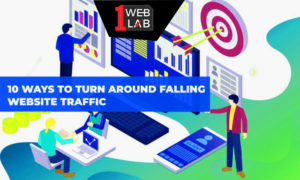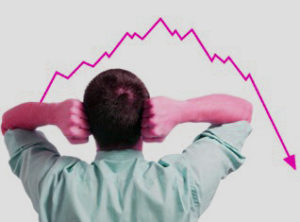Has your website experienced a decline in organic search traffic recently? 10 Ways To Turn Around Falling Website Traffic Here’s What to Do?When you lose a significant ranking for your key phrases, it’s all easy to panic, but in most cases the change is short-lived, and often it is possible to make a full recovery.
Declining Organic Traffic Crucially, there are actions you can take to find out why your traffic and rankings have fallen. Once you identify the reasons, you can work on a plan to help you climb back to where you want to be.
So, follow these 10 Ways To Turn Around Falling Website Traffic Here’s What to Do ?

Check for manual penalty
First of all, you will want to check the manual penalty. It is rare and highly unlikely that you will face manual penalties from Google, but this is the most identifiable root cause of the problem. If you’re experiencing manual penalties, your organic traffic will drop very quickly and immediately, and you’ll receive a notification in Google Search Console that your site has been penalized – if you don’t see both of those signs , You are probably in the clear.
If you have received a fine, you will need to fix any problems with your site responsible for the fine – such as spoiled or literary content or spam, a black-hat optimization strategy – and then appeal the penalty with Google Or wait for the penalty to be lifted.
Changes in search behavior and trends
Organic search traffic and a drop in rankings sometimes have nothing to do with your content or external links. Sometimes, drops can occur for reasons that are beyond your control.
Google’s search algorithms are constantly changing. These changes are accompanied by additional changes to how search results are delivered to users. But this does not mean that things are completely out of your hands. Indeed, ignoring current search trends can greatly affect the search visibility of your site.
If your site’s major landing pages have experienced a drop in traffic and rankings, it may be worth refreshing their keyword goals to make sure your up-to-date people are looking for things .
Google Trends is a good place to start, as it can help you find out whether your targeted key phrases have either declined slowly or have dropped sharply. Additionally you can refer to Google Search Console’s search analytics data to get a recent snapshot of what you are currently searching to find your products and services.
Pause your ads
Another possibility is that paid search result traffic is cutting into your organic traffic. To some extent, this is expected. Investing in paid traffic can reduce your organic traffic, which should boost your overall traffic.
However, sometimes, your paid traffic cuts your organic traffic. It is possible that you have such a strong presence on paid keywords, that there is no benefit of buying ads there. The only way to know if your paid ad is responsible for your traffic drop is to stop the ad and see if your traffic resumes to previous or expected levels.
Audit your link profile
The quality and quantity of links you point to for your site have a direct impact on how high it ranks in organic search results. Therefore, a sudden, unexpected change in your link profile can cause a drop in ranking, and therefore, in organic traffic. Use a link-profiler such as Moose-Open Site Explorer to analyze the links pointing to your site, and determine whether either of the two trigger points (described below) account for the decline in search visibility.
First, look for any new links from spammy sources. Are there any new links on suspicious websites that you have created (or that have mysteriously appeared)? Second, are there links that appear to be spam?
Any of these can make your website less reliable for search engines. If so, you will need to remove those links by contacting and requesting the appropriate webmaster. If that fails, ask Google to remove the link.
Next, look for opportunities to create new, strong links to boost your link profile and site authority.
Check your competition
Are you losing ranking in your competition? You may not have lost that place yet, but your competitor has provided a new content that is providing more value than your own, and is already taking over your traffic.
If yes, then you have two options. You can accept that premise and focus on keywords or strategies that your competitor has not yet invested, or you can focus on head-to-head competition if you think you can Can succeed against the latest efforts. It will depend on your competitors and the resources you can dedicate to the task.
Problems with site SEO
Search engine optimization is what helps websites to rank high in the SERP. And, the highest ranking sites get the most visitors. Needless to say, poor site SEO can drastically affect your web traffic. For example, if you have recently removed top-performing content or stopped sharing on social media, a drop in traffic may come from those sources. The solution here is long term. You have to invest in high quality content that can show up in Google SERP, as well as resume promotion to re-engage your audience.
Another SEO issue is website speed. Online users will quickly leave a page that is too long to load. Fortunately, there are many ways to speed up your website and improve UX, which, in turn, increases conversion rates.
You have also lost traffic in particular, which used to drive a lot of traffic, or you are no longer earning back-links. Start by contacting people who used to link to you and see if you can get the lost link back. You also have to constantly reach official sites and link them to your site. This is possible only when you are creating quality content that provides more value to visitors.
SERP changes
For important queries for which you are losing traffic, check for anything strange happening on the SERPs (search engine results page). There may be no feature you have seen before on mobile (desktop, or both). Google is constantly testing new features to improve the search experience for users, and it can affect your SEO organic – even when your keyword’s ranking is stable.
Keyword ranking fluctuations
If there was a drop in your ranking, collect the questions that looked at the drop (via GSC) and see if there were any technical issues related to these questions page. Sometimes these are A / B tests, Google is running, sometimes it is a bug from Google, and sometimes these changes are competition or algorithm-driven. If you’re curious, check out Google Webmasters’ tweet on it.
Check your page type and traffic type
If your website traffic is falling, then it is better to know which page is lacking traffic. Is this your home page, blog page, category page or product page? This can give you an indication of where you went wrong while doing the SEO process, and you can make changes accordingly.
A drop in blog posts means that you need to market and promote the content of the pages through your digital marketing efforts.
Check the user experience
If you have fewer returning visitors, you need to improve the user experience by changing the layout of your blog page to make reading easier for users. People need to know about the navigation of the website, which needs to be done properly.
A bounce rate of a website can help you know what visitors are doing on your website; Whether they are enjoying the content or not, they are receiving and how long it takes them to stay on your website. Everything is important when it comes to ranking your website and getting your desired traffic back to your website.

10 Ways To Turn Around Falling Website Traffic Here’s What to Do? Solve your problem with us.
So, when your website traffic decreases, and you have no clue what to do next or have no time to explore things, 1WebLab is here to help you with your brand promotion, content marketing, digital marketing and a There is more to take responsibility. We are one of the best digital marketing company in Delhi. Message us or call us to begin your journey with us.
